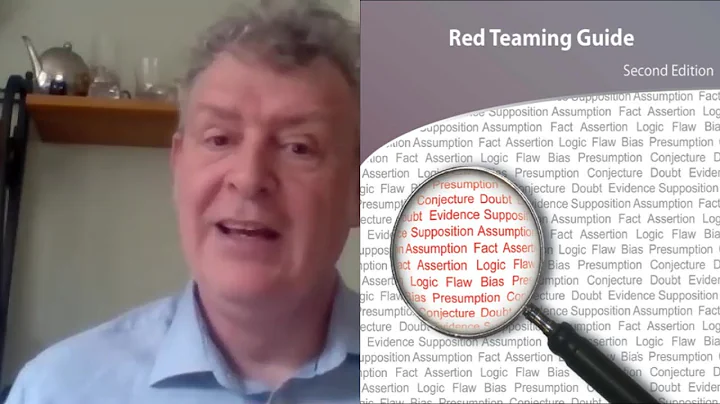Unraveling Einstein's Quantum Paradox
Table of Contents
- Introduction
- The Early Contributions of Albert Einstein
- The EPR Paper and Entangled States
- The Strange Implications of Quantum Mechanics
- Einstein's Objection to Entanglement
- The Argument of Hidden Variables
- John Bell and Testing the EPR Argument
- Experimental Findings and the Validity of Quantum Mechanics
- The Impact of the EPR Paper on Quantum Physics
- The Future of Quantum Information and Computing
- Conclusion
The Mysterious World of Quantum Mechanics
Albert Einstein, known for his groundbreaking work in physics, left an indelible mark on science with his theory of relativity and the famous equation E=mc^2. However, his contributions to the field of quantum mechanics are often overshadowed by these achievements. In 1935, Einstein, along with Boris Podolsky and Nathan Rosen, published a paper that would later become a foundation for a new understanding of quantum physics. This paper, known as the EPR paper, explored a strange phenomenon called entangled states.
1. Introduction
Quantum mechanics, a branch of physics that deals with the behavior of particles on a microscopic scale, has long perplexed scientists and challenged their intuitions about reality. In this article, we will delve into the fascinating world of quantum mechanics through the lens of Albert Einstein's contributions. We will explore the EPR paper and its implications, Einstein's objections to entanglement, and the subsequent experimental findings that validated the principles of quantum mechanics.
2. The Early Contributions of Albert Einstein
Albert Einstein played a pivotal role in the development of quantum mechanics. His theory of the photoelectric effect, which explained the behavior of light and electrons, was instrumental in launching the field. However, Einstein was troubled by the philosophical implications of quantum mechanics, particularly the notion of indeterminacy and the role of measurement in determining the state of a particle.
3. The EPR Paper and Entangled States
In their 1935 paper, Einstein, Podolsky, and Rosen introduced the concept of entangled states. They considered a scenario where pairs of particles were emitted from a source, each with two measurable properties. They observed that the measurements performed on one particle would instantaneously affect the state of the other, no matter the distance between them. This phenomenon came to be known as entanglement.
4. The Strange Implications of Quantum Mechanics
The EPR paper highlighted the peculiarities of quantum mechanics. It revealed that the measurements of particles were not only indeterminate until observed but also influenced by the measurements performed on their entangled counterparts. This led to the realization that the state of a particle was interconnected with its entangled partner, defying the principles of Einstein's theory of relativity.
5. Einstein's Objection to Entanglement
Einstein, renowned for his commitment to a deterministic view of the universe, had a difficult time accepting entanglement. He viewed it as a "spooky action at a distance" that violated the notion of locality, which held that no signal could travel faster than the speed of light. Einstein argued that entanglement indicated a fundamental incompleteness in quantum mechanics, suggesting the existence of hidden variables that determined the state of particles.
6. The Argument of Hidden Variables
Supporters of orthodox quantum theory, led by Niels Bohr, disagreed with Einstein's objection. They maintained that quantum states were genuinely indeterminate and that entanglement allowed the state of one particle to depend on its distant partner. The debate between Einstein and Bohr remained unresolved for decades until the introduction of John Bell's work.
7. John Bell and Testing the EPR Argument
John Bell devised a way to experimentally test the predictions of the EPR argument. His work showed that the outcomes of measurements on entangled particles were inconsistent with the limitations imposed by local hidden variable theories. Numerous experiments conducted since the 1970s have consistently validated the principles of quantum mechanics, confirming that the correlations between entangled particles are real and cannot be explained by hidden variables.
8. Experimental Findings and the Validity of Quantum Mechanics
The experimental findings in favor of quantum mechanics have laid to rest many of the doubts surrounding the EPR paper. Quantum mechanics, with its inherent indeterminacy and entanglement, offers a more accurate description of the microscopic world. It has become a cornerstone for scientific research and technological advancements, particularly in the emerging field of quantum information.
9. The Impact of the EPR Paper on Quantum Physics
Although the EPR paper was ultimately proven wrong, it played a crucial role in the development of quantum physics. It sparked a deeper understanding of the foundations of quantum mechanics and prompted further exploration of related topics, such as quantum information and computing. The concepts introduced in the EPR paper continue to shape our understanding of the quantum world.
10. The Future of Quantum Information and Computing
The field of quantum information, which leverages the principles of quantum mechanics, holds great promise for the future. Researchers are actively working to harness the unique properties of quantum systems to develop technologies such as quantum computers, which have the potential to revolutionize computing power. Quantum information has opened up new avenues for scientific inquiry and technological innovation.
11. Conclusion
Albert Einstein's contributions to quantum mechanics, particularly the EPR paper, have had a profound impact on our understanding of the quantum world. The strange phenomena of entanglement and indeterminacy challenged traditional notions of reality and led to significant advancements in the field. As we continue to explore the mysteries of quantum mechanics, the legacy of Einstein's work remains a foundational pillar in the realm of physics.
Highlights:
- Albert Einstein's role in the development of quantum mechanics and the EPR paper
- The concept of entangled states and their implications
- Einstein's objections to entanglement and hidden variables
- John Bell's experiments and the validation of quantum mechanics
- The impact of the EPR paper on quantum physics and the future of quantum information and computing
FAQ:
Q: What is entanglement in quantum mechanics?
A: Entanglement refers to the phenomenon where two or more particles become linked in such a way that the state of one particle is immediately correlated with the state of another, regardless of the distance between them.
Q: How did Einstein object to entanglement?
A: Einstein believed that entanglement violated the principles of his theory of relativity due to the instantaneous correlation between particles at any distance. He argued that there must be hidden variables determining the outcomes of measurements.
Q: How was the EPR argument tested?
A: John Bell devised a series of experiments to test the predictions of the EPR argument. These experiments showed that the correlations between entangled particles could not be explained by local hidden variable theories.
Q: What impact did the EPR paper have on quantum physics?
A: Although the EPR paper was proven wrong, it sparked further exploration into the foundations of quantum mechanics. It paved the way for the development of quantum information and computing, which have the potential for groundbreaking advancements.
Q: What is the future of quantum computing?
A: Quantum computing, utilizing the principles of quantum mechanics, holds the potential to revolutionize computing power. Researchers are actively working on harnessing the unique properties of quantum systems to develop more powerful and efficient computers.







